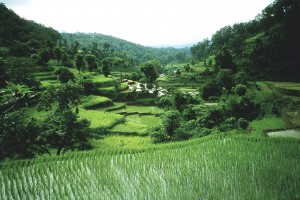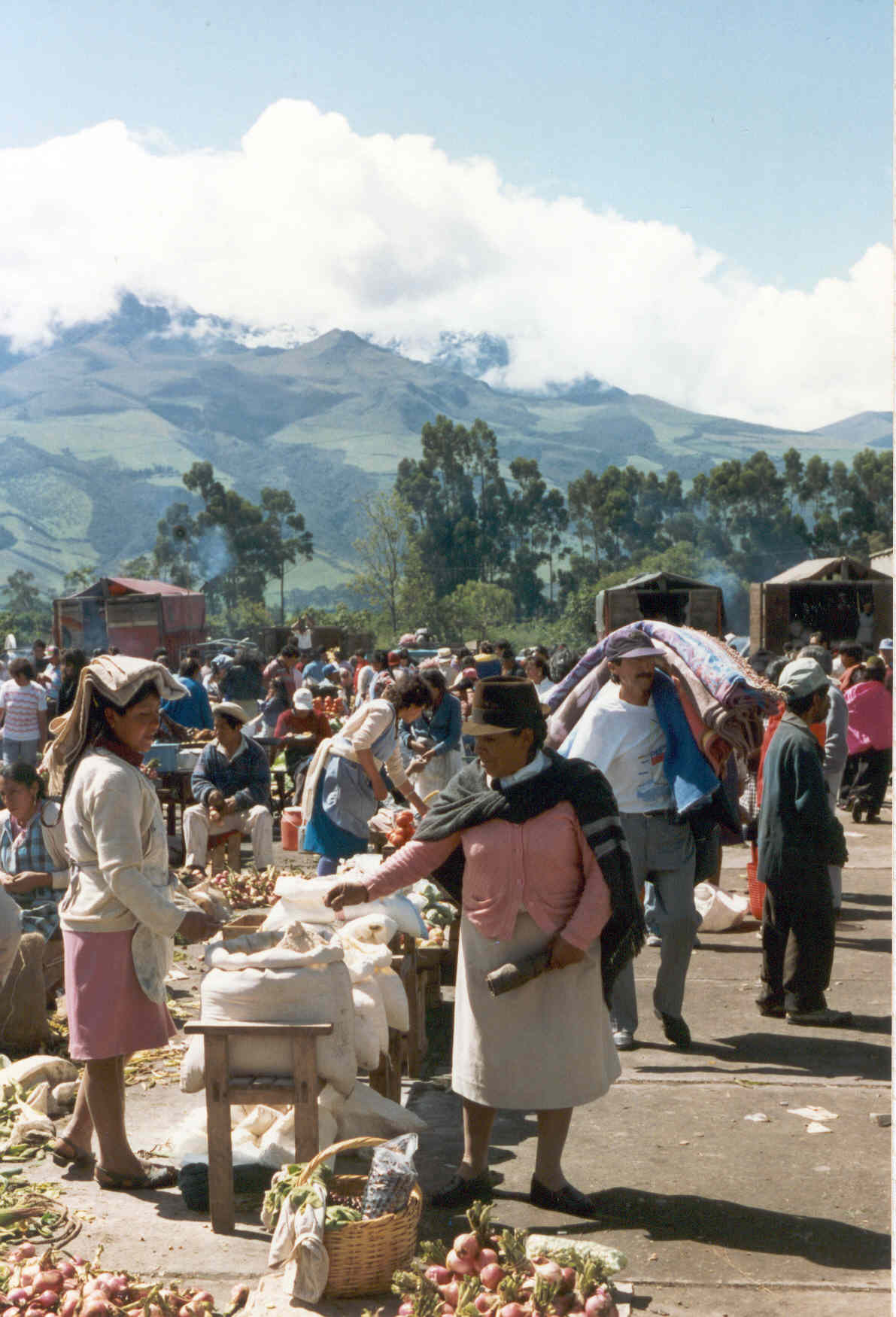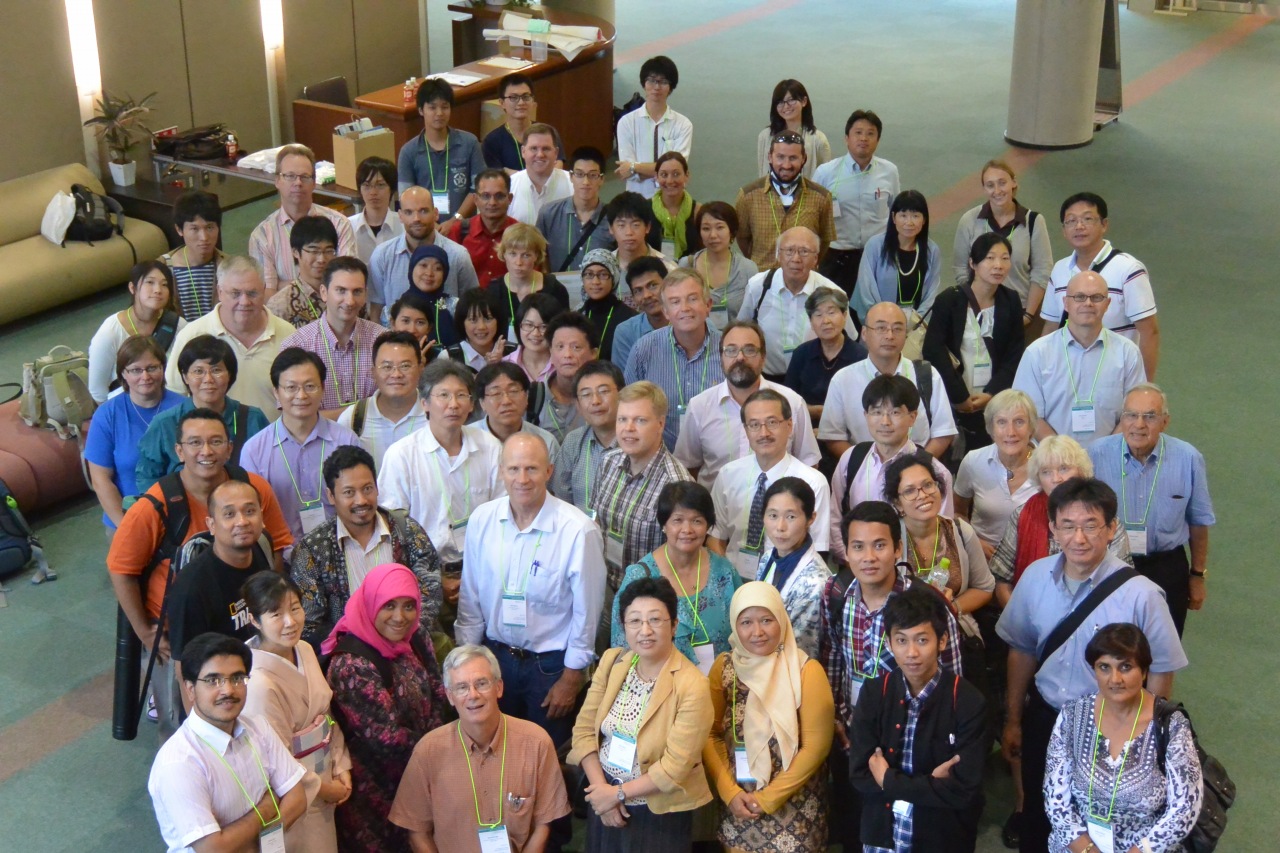Enhancing forest-related development: Community and smallholder forestry in the nexus of markets, policy, and implementation
Forests hold the potential to contribute to sustainable local development in many regions of the world. For this potential to be realized, rural dwellers need to have access to healthy forests, need to be linked to markets, and hold capacities to actively engage in forest product value chains. This requires an enabling legal environment and supportive policies. For the last two decades, considerable efforts and investment have been devoted to improve these enabling conditions in many locations and at different scales. Even so, in many places in the world where a forestry development potential may exist, deforestation and forest degradation, unfavourable legal environments and policies and competition with better endowed or politically well-connected entrepreneurs prevail. Read more…
Spotlight #29 – Supersites for Superior Forest Science
Supersites for Superior Forest Science
The initiative for establishing Supersites for forest research is only a few years old.
In these supersites, sophisticated, state-of-the-art instruments are used and a multitude of factors in the ecosystem is to be measured to obtain baseline data. As examples: spectrometers will measure how trees absorb and scatter light; laser scanners will map the forest’s three-dimensional structure; soil, plant and atmospheric sciences will be integrated; and mechanistic and policy-oriented modeling will be part of the concept. Read more…
Congress Spotlight #28: American Indian forestry: blending science and tradition
American Indian forestry: blending science and tradition
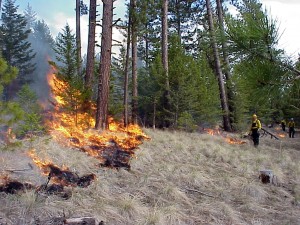
Prescribed fire used by the Tribes for centuries (Flathead Indian Reservation managed by the Confederated Tribes of the Salish and Kootenai Tribes). Photo by IFMAT-III
For thousands of years, American Indians have been managing the forests in which they live.
Today, with trained professionals who are tribal members, their forests are managed with modern tools and methods; include manufacturing facilities and address global forest issues such as climate change, forest certification, carbon sequestration and a changing work force.
Congress Spotlight #21 – The forest pharmacy and food store
The forest pharmacy and food store
Sometimes, they say, you can’t see the forest for the trees.
And one group of sub-plenary session organizers for the upcoming IUFRO World Congress in Salt Lake City might amend that to read: “Sometimes you can’t see the forest for anything but the timber value in the trees.”
The organizers – Hannu Raitio and Tuija Sievänen of the Finnish Forest Research Institute; James Chamberlain of the U.S. Forest Service; and Carsten Smith-Hall of Denmark’s University of Copenhagen, will present a session entitled: The value and challenges of integrating food and medicinal forest products into forest management.
New expert panel assesses linkages between forests and food security
Forests play a major role in achieving Millennium Development Goal 1 to eradicate extreme poverty and hunger and in striving for food security. Globally, millions of people depend on forests for their food security and nutrition, directly through the consumption or sale of foods produced in forests, indirectly through forest-related employment and income, forest ecosystem services, and forest biodiversity.
Current approaches to increasing food security tend to concentrate on agricultural solutions, ranging from intensification of agricultural production outside of forests to promoting agroforestry systems. Policy recommendations to establish a framework for promoting food security from forests, however, have so far been rather general and no framework addresses the relationship between forests and food security directly.
The “International Conference on Forests for Food Security and Nutrition”, held at FAO Headquarters in Rome in May 2013, inter alia conveyed the key message that forests, trees and agroforestry systems demand greater attention in strategies for food security and nutrition and in the fight against hunger. It also called for improved data collection at national and international levels.
Adding a gender perspective helps to better understand future challenges of small-scale and community-based forestry
Report from the IUFRO 2013 Conference on Future Directions of Small-scale and Community-based Forestry, Fukuoka, Japan, 8-13 September.
Community-based forestry and small-scale forestry are of key importance for sustaining sound forest management in both developed and developing countries. Small-scale forestry provides important environmental protection, landscape conservation and rural development benefits as well as timber production in many countries. However, small-scale forestry faces major challenges in developed and semi-developed countries, especially associated with aging, declining birthrates, depopulation, and unemployment in rural districts.
In many countries, small and fragmented forestland ownership is quite common. In some countries, communal forest ownership as a residue from feudal eras is still alive and has been managed by rural communities.
Inviting Latin America to play a bigger role in IUFRO
(Edited translation of press release)
Find the Spanish release written by Karla Salazar Leiva, CATIE Communications, at:
http://web.catie.ac.cr/iufrolat/IufroLat_prensa.htm
On 14 June, the Third IUFRO Latin American Congress (IUFROLAT 2013), one of the largest forest research events in Latin America, came to a close.
IUFROLAT III Session Highlights: Utilization of Forest Products
Aprovechamiento de productos forestales / Utilization of Forest Products
Session moderator: Don K Lee, IUFRO Immediate Past President, Korea
Find more information about IUFRO’s Division on Forest Products: www.iufro.org/science/divisions/division-5/
The primary objective of the first paper was to determine if Caesalpinia velutina and Giricidia sepium fuelwood plantations in Nicaragua could be economically viable for smallholders. It was concluded that fuelwood plantation yields according to product-specific requirements were essential for the economic viability analysis. In the context of this study and contrarily to public perception, farm-based Caesalpinia velutina and Giricidia sepium fuelwood plantations could be economically viable over longer rotations.
The second paper addressed the role of Sewage Treatment Plants (STPs). The sewage treatment process generates a solid waste named sewage sludge, a material rich in organic matter and nutrients. According to this study sewage sludge showed a great potential in the production of forest seedlings. It recommends the use of composite substrates with sewage sludge, because it minimizes the need for acquisition of commercial substrates, decreasing production costs by increasing productivity and disposing this waste in a more sustainable way.
The aim of the third paper was to contribute to the understanding of the growth dynamics of native species of Araucaria taking into account its complex structure and by the analysis of growth and competition, to subsidize the forest management and its conservation. The endeavour of trees to compete for light can be used to determine the best management and production options.
The fourth paper studied the growth dynamics of different species in an Araucaria forest remnant stand. It concluded that there is evidence that in the past the stand of Araucaria Angustifolia should have been thinned more intensively. Competition indexes are useful and can be used to recover information in unmanaged stands to optimize resources, and they can also be used as a reference to manage other stands in similar conditions.
The aim of the fifth paper was to determine the percentage of samples that best reflects the actual diameter distribution in a 1,000 ha of primary Amazon forest in Sinop, Mato Grosso State, Brazil. When considering the whole area, 5% sample intensity has proven to be sufficient to estimate the horizontal structure of trees above 30 cm of DBH. Considering the diversity of the Amazon rainforest, it is still not possible to extrapolate this anlysis of the diameter distribution. Further replication studies are required to establish sample intensities and methods for different forest structures.
Presentations in this session:
Using Product-Specific Fuelwood Yields to Assess Economic Visability: A Case Study of Farm-Based Gliricidia sepium and Caesalpinia velutina Plantations in Nicaragua. (Kahlil Baker, UBC, Canada)
Utilization of sewage sludge in the composition of substrates in forest seedlings production. (Alan Marques Abreu, UFRRJ Brazil)
Growth dynamics of different species in an Araucaria Forest remnant. (Aline Canetti, Embrapa Florestas, Brazil)
Competition index: a tool to define thinning in stands of Araucaria angustifolia. (Rafaella Curto, Embrapa Florestas, Brazil)
Determination of sampling intensities to estimate diameter distribution in Amazon Forest. (Mariana De Oliveira Ferraz, Embrapa Florestas, Brazil)
IUFROLAT III Session Highlights: What REDD+ Looks Like on the Ground
What REDD+ looks like on the ground: evidence from the Amazon and beyond
Moderator: Niels Elers Koch, IUFRO President
Thursday, 13 June 2013, 08:00 – 10:00 (Santa Rosa 2)
Agricultural expansion has been identified as a key driver of deforestation in developing countries. The IPCC estimated that carbon dioxide emissions, as a consequence of deforestation, amounted to 20% of all anthropogenically induced carbon dioxide emissions in the 1990s. Reducing Emissions from Deforestation and Forest Degradation in developing countries (REDD+), has been proclaimed an environmental policy instrument that could potentially provide mitigative benefits for net carbon emissions and biodiversity degradation.
In the session entitled “What REDD+ looks like on the ground: evidence from the Amazon and beyond”, leading scientists addressed the relationship between biodiversity, carbon, forests and people, as well as experiences with the operationalization of REDD+ in Latin America.
The Global Forest Expert Panel (GFEP), which is coordinated by IUFRO, presented a global assessment report on REDD+, which consolidates the research of more than 50 leading scientists. The report constitutes a comprehensive analysis of the synergies and trade-offs between biodiversity, forest management and REDD+.
The assessment report proposes that biodiversity is paramount, as a prerequisite for providing ecosystem services. In the face of disturbance regimes such as climate change, ecosystem resilience, a product of biodiversity, ensures ecosystem service provision.
Moreover, a successful REDD+ implementation, that achieves mitigative net carbon emissions and ensures biodiversity provision, requires, in conjuncture with the implementation, the pursuit of social objectives by securing tenure rights and local engagement. Only when tenure and property rights are clearly defined can a REDD+ implementation be effective.
The session also included presentations on a global comparative study entitled “What REDD+ looks like on the ground: Carried out by CIFOR”. The study, which is t largest project ever undertaken by CIFOR, aims to provide scientific insights on how to ensure that REDD+ measures meet the three “E’s”; Effectiveness, Efficiency, Equity. As the first phase of the study has been completed, the findings of four cases were presented during the session. For more detailed information please visit the CIFOR webpage.
The Global Forest Expert Panel report can be downloaded at www.iufro.org/science/gfep
Presentations in this session:
Understanding relationships between biodiversity, carbon, forests and people: the key to achieving REDD+ objectives (John Parrotta, US Forest Service, USA)
What REDD+ looks like on the ground (Amy Duchelle)
Smallholder typology at a REDD+ project site in the Eastern Brazilian Amazon. (Marina Cromberg, CIFOR, Brazil)
Analyzing payments for environmental services as a way to improve social, economic and environmental resilience in rural settlements in northwestern Mato, Grosso, Brazil. (Raissa Guerra, University of Florida, Brazil)
Conservation transfers, livelihoods and land use: the case of Bolsa Floresta, Amazonas, Brazil (Amy Duchelle and Kim Bakkegaard)
Livelihoods, land use, land cover change and the implications for REDD+ in Brazil nut concessions in the Peruvian Amazon. (Valerie Garrish, CIFOR)
Understanding Relationships between Biodiversity, Carbon, Forests and People: The Key to Achieving REDD+ Objectives
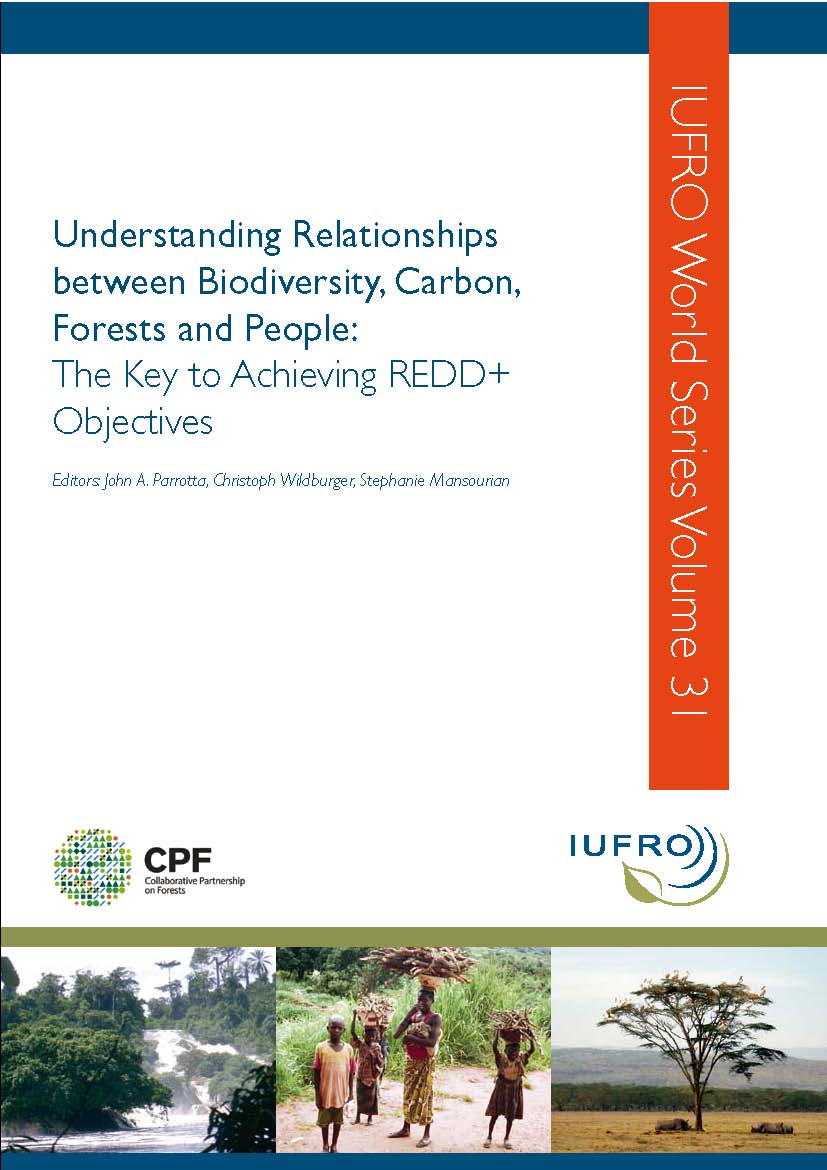 New GFEP assessment report published as IUFRO World Series 31
New GFEP assessment report published as IUFRO World Series 31
Edited by: John A. Parrotta, Christoph Wildburger, Stephanie Mansourian
Forests harbour a major proportion of the world’s terrestrial biodiversity and provide a wide range of vitally important ecosystem services – including carbon sequestration and storage. Deforestation and forest degradation continue to erode biodiversity and the capacity of forest ecosystems to help mitigate climate change and provide the goods and services that sustain livelihoods and human well-being locally, and globally. Reducing greenhouse gas emissions from deforestation and forest degradation, and enhancing forest carbon stocks in developing countries (REDD+) is a proposed mechanism which has the potential to realise its primary objective – climate change mitigation – with variable impacts, positive and negative, on biodiversity, forests and people. REDD+ is complex, its proposed activities and implementation mechanisms not yet clearly defined, and therefore surrounded by uncertainty. Because of its high relevance to climate change mitigation, the conservation and sustainable use of forests and their biological diversity, the Expert Panel on Biodiversity, Forest Management and REDD+ was established by the Collaborative Partnership on Forests in December 2011 to carry out this assessment.
The Expert Panel included 24 scientists and other experts from a variety of biophysical and social science disciplines relevant to the topics covered in this assessment report. An additional 18 contributing authors added their expertise to the assessment. Each chapter was prepared by a team of Lead Authors and Contributing Authors led by one or more Coordinating Lead Authors. A full draft of the report and its individual chapters was peer-reviewed prior to its completion. The results of this voluntary collaboration between January and October 2012 are presented in the six inter-related chapters comprising this book.
This assessment report evaluates the implications of forest and land management interventions envisaged under REDD+ in a multidimensional and integrated fashion. It summarises the most current scientific literature that sheds light on the relationships between forest biodiversity and carbon (and other ecosystem services), how these complex relationships may be affected by management activities implemented to achieve REDD+ objectives, the potential synergies and tradeoffs between and among environmental and socio-economic objectives, and their relationship to governance issues. Based on the main findings of the assessment (summarised in Chapter 6), a policy brief entitled ‘REDD+, Biodiversity and People: Opportunities and Risks’ has been prepared especially for policy- and decision-makers.
The full report is formally presented at Forest Day 6 on 2 December during the United Nations Framework Convention on Climate Change (UNFCCC) meeting in Doha, Qatar (26 November-7 December, 2012).
The report, the policy brief and a press release – New Study Suggests Global Pacts Like REDD Ignore Primary Causes of Destruction of Forests – are available for download.
Report and Policy Brief: http://www.iufro.org/science/gfep/biodiv-forman-redd-panel/report/
Press Release: http://www.iufro.org/science/gfep/media-information/gfep-bfmr-assessment-press-release/
For more information about the Expert Panel on Biodiversity, Forest Management and REDD+, please visit:
http://www.iufro.org/science/gfep/biodiv-forman-redd-panel/

